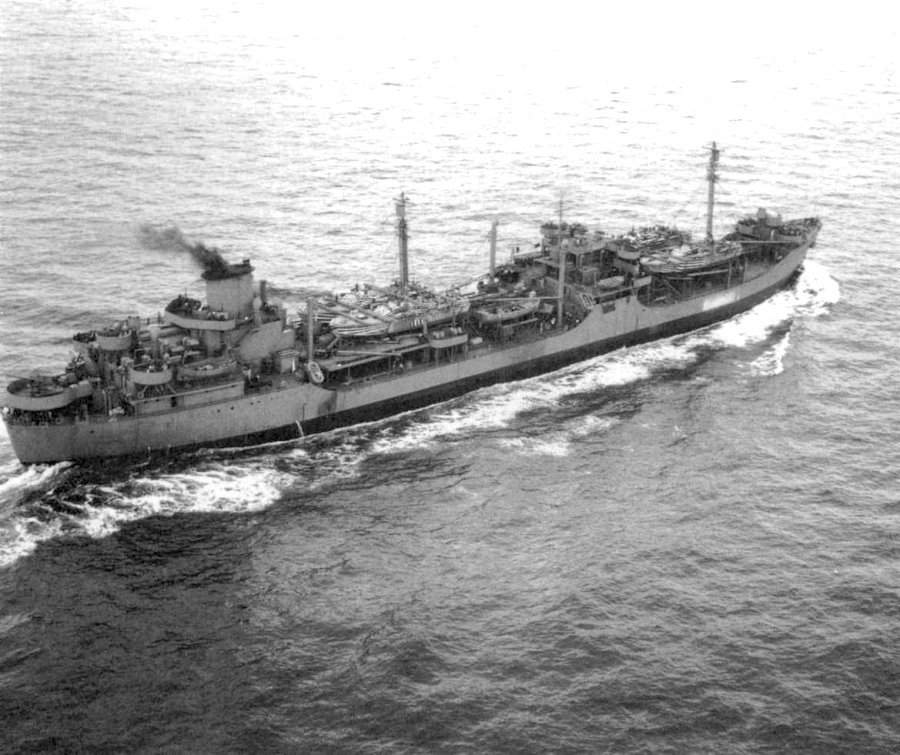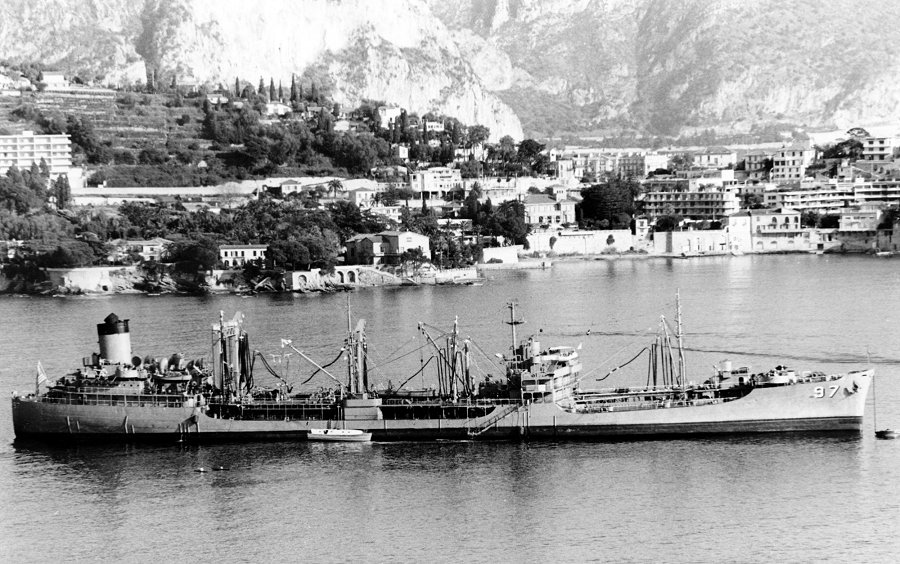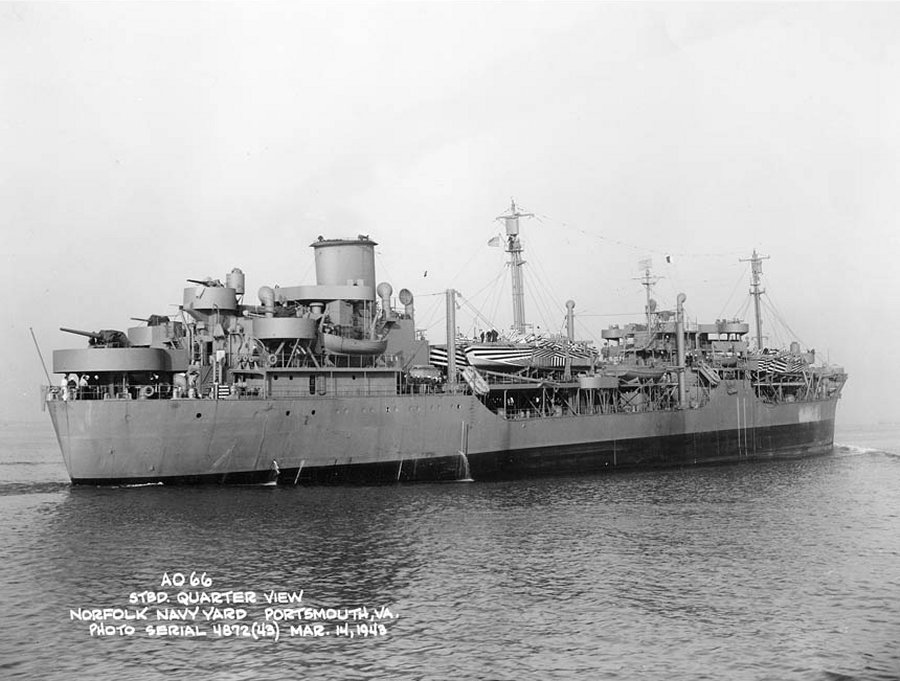Auke Visser's International Esso Tankers site | home
Esso Columbia (II) - (1942-1942)
"Esso Columbia" was build in 1942 and handed over to the US Navy. Renamed "USS Atascosa (AO-66)".
After the war she returned as "Esso Syracuse" in 1947.

"Esso Columbia" was build in 1942 and handed over to the US Navy. Renamed "USS Atascosa (AO-66)".
USS Atascosa (AO-66), ex. "Esso Columbia (II)", underway off Norfolk Navy Yard, 14 March 1943, outbound for the Pacific.
Note she has a deck cargo of four PT boats, probably to be off-loaded in New Caladonia.
( Photo thanks to Mike Green )
USS Atascosa (AO-66), ex. "Esso Columbia (II)", underway off Norfolk Navy Yard, 14 March 1943, outbound for the Pacific.
Note she has a deck cargo of four PT boats, probably to be off-loaded in New Caladonia.
( Photo thanks to Mike Green )
See her also as : Esso Syracuse - (1947-1961)
Additional Info :
Atascosa Class Fleet Oiler: A Maritime Commission type tanker hull, laid down, as Esso Columbia II, for Standard Oil
of New Jersey, under a Maritime Commission contract at Sun Shipbuilding and Dry Dock Co., Chester, PA; Launched, 7
September 1942; Acquired by the US Navy, 12 October 1942; Commissioned USS Atascosa (AO-66), 9 November 1942;
Decommissioned, 21 January 1946, at Mare Island Navy Yard, Vallejo, CA.; Struck from the Naval Register, 7 February 1946;
Transferred to the Maritime Commission, 1 July 1946, for lay up in the National Defense Reserve Fleet; Sold to the Standard
Oil Company of New Jersey in 1947 and renamed Esso Syracuse; Sold to General Cargo
Corporation, converted to a freighter, renamed Spitfire.; Final Disposition, fate unknown.
Displacement 5,730 t.(lt) 24,660 t.(fl); Length 547' 3"; Beam 70'; Draft 31'; Speed 15.5 kts; Complement 281;
Armament one single 5"/38 dual purpose gun mount, four single 3"/50 dual purpose gun mounts, four twin 40mm gun mounts,
four twin 20mm gun mounts; Capacity 156,000 barrels; Propulsion, GE turbo-electric, single propeller, 6,000 shp.
AO-66 Atascosa
A river in Texas that rises in Frio County some 25 miles southwest of San Antonio, runs eastward and southerly through Atascosa
County, and joins the Frio River a few miles above its confluence with the Nueces River, which then flows southeast to empty
into Corpus Christi Bay.
(AO-66: dp. 24,660:1. 547'3"; b. 70'; dr. 31': s. 15.5 k.; cpl. 281; a. 15", 4 3", 4 40mm.)
Esso Columbia was built at Chester, Pa., by the Sun Shipbuilding and Dry Dock Co. for the Standard Oil Company of New Jersey;
launched on 7 September 1942; sponsored by Mrs. Harold G. McAvenia; renamed by the Navy Atascosa: designated AO-66 on 16
September 1942; purchased by the Navy on 12 October 1942: and commissioned on 9 November 1942, Lt. Comdr.
Melvin H. Bassett in command.
Following her commissioning at Baltimore, Md., the oiler sailed to Hampton Roads, Va., where she arrived on 19 November. At the
conclusion of a month of trials, she got underway on 19 December for Port Arthur, Tex., where she took on a cargo of fuel oil and
gasoline and then returned to Norfolk on 3 January 1943.
After a two-day respite, Atascosa left the east coast, bound for Bermuda. She spent one week there before sailing back into Norfolk
on 16 January. Atascosa made another run to Port Arthur for more oil and discharged that cargo at Norfolk before entering a drydock at the
Norfolk Navy Yard for a brief period the oiler was refloated, she began preparations to the Pacific.
Norfolk on 19 March and, after stops at Galveston and Baytown, Tex., transited the Panama Canal on 4 April. Her ultimate destination
was Noumea, New Caledonia, which she reached on 28 April. The oiler discharged her cargo and then loaded more fuel oil and aviation
gasoline to be taken to Samoa. She arrived at Pago Pago on 4 May, but left the next day, bound for the United States, and reached San
Pedro, Calif., on 28 May. There, she took on a cargo of petroleum and aircraft for transportation to Suva, Fiji Islands, and Noumea, New
Caledonia. More shuttling between the west coast and these ports and the west coast occupied June, July, and August. In early Septem-
ber, Atascosa left Noumea and set course for Espiritu Santo, New Hebrides. She arrived there on 9 September and began her duties
fueling various ships of the fleet. In October, the oiler added Tulagi and Guadalcanal in the Solomon Islands to her fueling stops. She
broke this routine somewhat by a trip to Nandi Bay in the Fiji Islands, where she arrived on Christmas Eve 1943. After delivering fuel
and supplies, she again got underway on 11 January 1944 to return to Espiritu Santo.
Atascosa put to sea on 15 February to rendezvous with Rear Admiral Merrill's Task Force (TF) 39. She fueled three cruisers and four
destroyers at sea before returning to Purvis Bay. A second fueling rendezvous with TF 39 took place on 6 March. The oiler stopped
briefly at Purvis Bay, then went to Espiritu Santo on 15 March to begin preparations to rendezvous with a part of TF 58. The meeting
occurred at sea on 26 March. Shortly after midnight on the morning of 28 March, Atascosa was informed that a Liberator bomber had
gone down in the vicinity of the fueling group, and she began a search for its crew. Observers on the oiler spotted a life raft, but it proved
to be unoccupied, and Atascosa soon terminated her rescue efforts. On 29 March, she was servicing units of Destroyer Divisions 93
and 94 when a Japanese plane closed the group. After AtascosaAtascosa retired to Espiritu Santo on 5 April.
On 21 May, Atascosa left New Caledonia, bound for the west coast. She arrived at Terminal Island, Calif., on 7 June to undergo a routine
overhaul and repairs. The yard work was completed on 22 July, and the ship got underway to return to her wartime duties. She touched
briefly at Pearl Harbor before finally arriving at Eniwetok on 11 August. There, she unloaded her deck cargo and serviced a number of
destroyers. Standing out to sea on the 17th, the ship fueled battleships Iowa (BB-61), Indiana (BB-58), and Alabama (BB-60). At a
rendezvous with the fast carrier task force between Rota and Guam on 4 September, Atascosa serviced several destroyers and
aircraft carrier Enterprise (CV-6).
Air alerts interrupted the oiler's routine at Saipan between the 5th and the 9th, before she steamed to Guam. During September Atascosa
fueled many units of TF 38. She made stops at Saipan and Eniwetok before arriving at Ulithi on 13 October. She got underway again on
21 October to rendezvous with TG 30.8 in an area east of Luzon. The oiler was fueling TF 38.3 in early November when she encountered
high, seas and increasingly strong winds. During the operation, those lines between ships were carried away several times. On 7 November,
while fueling Langley (CVL-27), the steel manifold on the after port 6-inch connection was carried away, forcing the suspension of opera-
tions. Six members of Atascosa's crew were injured while making and tending gasoline connections. The weather abated November,
allowing the oiler's crew to make temporary repairs so that fueling could be resumed. Atascosa put into port at Ulithi on 17 November. She
sailed on 10 December to meet fast carrier forces off Cape Engano and again encountered heavy seas. This soon developed into a typhoon;
and, by 18 December, visibility was reduced to zero. The next day, the weather had improved enough to allow fueling to resume. Atascosa
returned to Ulithi on 23 December for the Christmas holidays.
During January and February 1945, Atascosa supported the operations of TG 30.8 and made several meetings with TF 58. She dropped
anchor at Ulithi on 3 March for repair work. The ships of TF 58 left Ulithi several day's before Atascosa departed on 19 March to support
their attacks on the Japanese homeland. Her next assignment was to fuel the ships of TG 50.8, which were anchored off Okinawa. Atascosa
returned to Ulithi on 1 May to undergo repairs and to replenish supplies. In mid-June, Atascosa set her course for Okinawa, where she re-
mained for a month. After a brief supply stop at Ulithi, the oiler put to sea on 8 August to rendezvous with TF 38 off southern Honshu.
While engaged in this mission, she received word of Japan's capitulation.
Atascosa returned to Ulithi on 31 August. However, her service in the Pacific had not yet ended, as she left on 8 September to steam to
Tokyo Bay. She remained in Japan until 24 September, then sailed to San Pedro, Calif The oiler arrived back in the United States on 8 October.
Atascosa was decommissioned on 21 January 1946 at Mare island, Calif; her name was struck from the Navy list on 7 February; and
she was transferred to the Maritime Commission on 1 July 1946.
Sold to the Standard Oil Company of New Jersey in 1947 and renamed Esso Syracuse, she transferred to Panamanian registry in 1950
but continued serving as Esso Syracuse. Later that year, she was sold to the General Cargo Corporation, converted to a freighter,
reregistered under the American flag at New York City, and renamed Spitfire. She served under that name until
she returned to Panamanian registry in 1973.
See also : Spitfire
The Miramar Ship Index for "ESSO COLUMBIA"
IDNo:
|
5615849
|
Year:
|
1942
|
Name:
|
ESSO COLUMBIA
|
Launch Date:
|
07.04.1942
|
Type:
|
Tanker
|
Date of completion:
|
10.1942
|
Flag:
|
USA
|
Keel:
|
Ton:
|
11344
|
Link:
|
-
|
DWT:
|
Yard No:
|
216
|
|
Length overall:
|
Ship Design:
|
||
LPP:
|
Country of build:
|
USA
|
|
Beam:
|
Builder:
|
Sun
|
|
Material of build:
|
Location of yard:
|
Chester, Pa
|
|
Number of screws/Mchy/Speed(kn):
|
|||
Subsequent History:
1942 ATASCOSA - 1946 ESSO COLUMBIA - 1947 ESSO SYRACUSE
Disposal Data:
Scrapped at Genoa 60 (forepart joined to ESSO BUFFALO ID # 2243473]
History :
ON
|
LR/IMO
|
ID
|
Year
|
Name
|
Tons
|
Change
|
Main Owner
|
5615849
|
1942
|
ESSO COLUMBIA
|
11344
|
Standard Oil Co NJ.
|
|||
AO-66
|
5615849
|
1942
|
ATASCOSA
|
11344
|
1942
|
U.S.Navy
|
|
253851
|
5615849
|
1942
|
ESSO SYRACUSE
|
11344
|
1947
|
Standard Oil Co NJ
|


